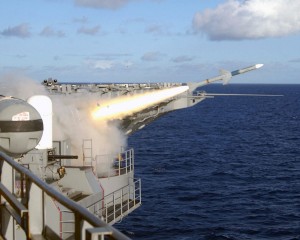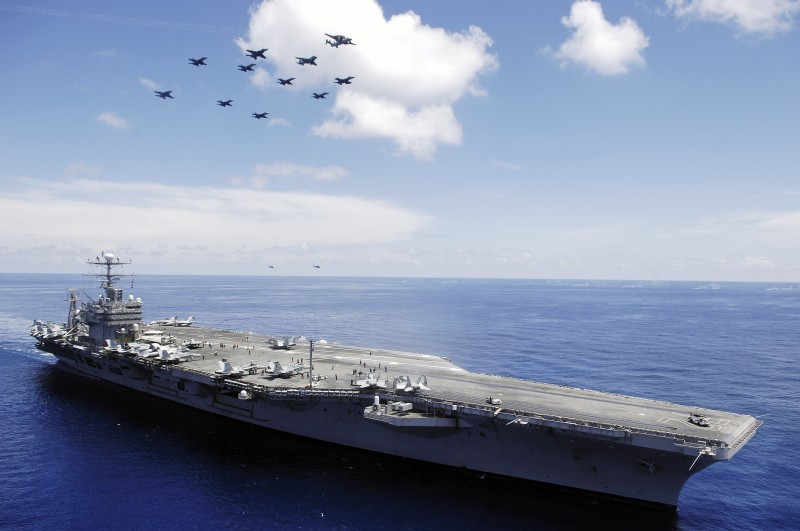Imagine a floating air-force base holding 2 squadrons of aircraft, 23 stories high, as wide as the Empire Estate building, weighing a 100,000 tonnes and travelling at more than 30 knots with an unlimited range due to its nuclear reactors which can keep the ship powered for 25 years. The Nimitz-class supercarriers are a class of ten nuclear-powered aircraft carriers in service with the United States Navy. The lead ship of the class is named for World War II Pacific fleet commander Chester W. Nimitz, who was the Navy’s last fleet admiral. With an overall length of 1,092 ft (333 m) and full-load displacements of over 100,000 long tons, they are the largest capital ships in the world.
Instead of the gas turbines or diesel-electric systems used for propulsion on many modern warships, the carriers use two A4W pressurized water reactors which drive four propeller shafts and can produce a maximum speed of over 30 knots (56 km/h) and maximum power of around 260,000 shp (190 MW). As a result of the use of nuclear power, the ships are capable of operating for over 20 years without refueling and are predicted to have a service life of over 50 years.
Today’s aircraft carriers are so expensive that many nations risk significant political, economic, and military ramifications if one were lost, or even used in conflict. Observers have opined that modern anti-ship weapons systems, such as torpedoes and missiles, have made aircraft carriers obsolete as too vulnerable for modern combat. Nuclear weapons would threaten whole naval carrier groups in open generalised combat. On the other hand, the proven or threatening role of aircraft carriers has an undeniably modern place in asymmetric warfare, like the gunboat diplomacy of the past. Furthermore, aircraft carriers facilitate quick and precise projections of overwhelming military power into such local and regional conflicts.
The Nimitz class carriers have an overall length of 1,092 ft (333 m) and a full-load displacement of about 100,000–104,000 long tons (102,000–106,000 metric tons). They have a beam at the waterline of 135 ft (41 m), and the maximum width of their flight decks is 251 ft 10 in to 257 ft 3 in (77.76 m to 78.41 m) (depending on the variant). The ships’ companies can number up to 3,200, not including an air wing of 2,480.
Propulsion
 All ships of the class are powered by two A4W nuclear reactors, kept in separate compartments. They power four propeller shafts and can produce a maximum speed of over 30 knots (56 km/h) and maximum power of 260,000 bhp (190 MW). The reactors produce heat through nuclear fission which heats water. This is then passed through four turbines (manufactured by General Electric) which are shared by the two reactors. The turbines power the four bronze propellers, each with a diameter of 25 feet (7.6 m) and a weight of 66,000 pounds (30 t). Behind these are the two rudders which are 29 feet (8.8 m) high and 22 feet (6.7 m) long, and each weigh 110,000 pounds (50 t). The Nimitz-class ships constructed since USS Ronald Reagan also have bulbous bows in order to improve speed and fuel efficiency by reducing hydrodynamic drag. As a result of the use of nuclear power, the ships are capable of operating continuously for over 20 years without refueling and are predicted to have a service life of over 50 years.
All ships of the class are powered by two A4W nuclear reactors, kept in separate compartments. They power four propeller shafts and can produce a maximum speed of over 30 knots (56 km/h) and maximum power of 260,000 bhp (190 MW). The reactors produce heat through nuclear fission which heats water. This is then passed through four turbines (manufactured by General Electric) which are shared by the two reactors. The turbines power the four bronze propellers, each with a diameter of 25 feet (7.6 m) and a weight of 66,000 pounds (30 t). Behind these are the two rudders which are 29 feet (8.8 m) high and 22 feet (6.7 m) long, and each weigh 110,000 pounds (50 t). The Nimitz-class ships constructed since USS Ronald Reagan also have bulbous bows in order to improve speed and fuel efficiency by reducing hydrodynamic drag. As a result of the use of nuclear power, the ships are capable of operating continuously for over 20 years without refueling and are predicted to have a service life of over 50 years.Armament and Protection
 In addition to the aircraft carried onboard, the ships carry defensive equipment for direct use against missiles and hostile aircraft. These consist of either three or four NATO RIM-7 Sea Sparrow missile launchers designed for defense against aircraft and anti-ship missiles as well as either three or four 20 mm Phalanx CIWS missile defense cannon. USS Ronald Reagan has none of these, having been built with the RIM-116 Rolling Airframe Missile system, two of which have also been installed on USS Nimitzand USS George Washington. These will be installed on the other ships as they return for Refueling Complex Overhaul(RCOH). Since USS Theodore Roosevelt, the carriers have been constructed with 2.5 in (64 mm) Kevlar armor over vital spaces, and earlier ships have been retrofitted with it: Nimitz in 1983–1984, Eisenhower from 1985–1987 and Vinson in 1989.
In addition to the aircraft carried onboard, the ships carry defensive equipment for direct use against missiles and hostile aircraft. These consist of either three or four NATO RIM-7 Sea Sparrow missile launchers designed for defense against aircraft and anti-ship missiles as well as either three or four 20 mm Phalanx CIWS missile defense cannon. USS Ronald Reagan has none of these, having been built with the RIM-116 Rolling Airframe Missile system, two of which have also been installed on USS Nimitzand USS George Washington. These will be installed on the other ships as they return for Refueling Complex Overhaul(RCOH). Since USS Theodore Roosevelt, the carriers have been constructed with 2.5 in (64 mm) Kevlar armor over vital spaces, and earlier ships have been retrofitted with it: Nimitz in 1983–1984, Eisenhower from 1985–1987 and Vinson in 1989.The other countermeasures the ships use are four Sippican SRBOC (super rapid bloom off-board chaff) six-barrel MK36 decoy launchers, which deploy infrared flares and chaff to disrupt the sensors of incoming missiles; an SSTDS torpedo defense system; and an AN/SLQ-25 Nixie torpedo countermeasures system. The carriers also use Raytheon AN/SLQ-32(V) electronic warfare systems to detect and disrupt hostile radar signals in addition to the electronic warfare capabilities of some of the aircraft on board.
The presence of nuclear weapons on board U.S. aircraft carriers since the end of the Cold War has neither been confirmed nor denied by the U.S. government. As a result of this, as well as concerns over the safety of nuclear power, the presence of a U.S. aircraft carrier in a foreign port has occasionally provoked protest from local people, for example when USSNimitz docked in Chennai, India, in 2007. At that time, the Strike Group commander Rear Admiral John Terence Blake stated that: “The U.S. policy is that we do not routinely deploy nuclear weapons on board Nimitz.”
